Managing / Unmanaging / Deleting Components in Bulk
Typically, administrators can manage/unmanage/delete multiple components of a chosen type, using the Components -Manage / Unmanage / Delete page of the eG admin interface. However, in large IT infrastructures characterized by hundreds of components of heterogeneous component types, managing/unmanaging/deleting components by type can take hours. To save the time and effort involved in these tasks, eG Enterprise allows administrators to manage/unmanage/delete components across types in bulk.
For managing components in bulk, do the following:
- Login to the eG admin interface.
- Follow the Infrastructure -> Components -> Manage/Unmanage/Delete menu sequence.
-
In Figure 7 that then appears, click the Bulk Manage/Unmanage/Delete button.

Figure 7 : Choosing to manage/unmanage/delete components in bulk
-
Figure 8 will then appear. To manage components in bulk, select the Manage option from Figure 8.
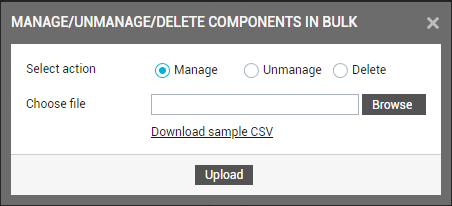
- Typically, you need to enter the details of all the components you want to manage in a CSV file. This file should then be uploaded to the eG manager, so that all the components configured in the CSV file are managed in one shot. To help you build this CSV file quickly, eG Enterprise provides you with a ready-to-use template. Click on the Download sample csv link in Figure 8 to download this CSV sample/template to the local host.
-
Next, proceed to edit the downloaded CSV sample/template. The template is pre-configured with columns to capture information pertaining to components. These columns are, namely - component type, component name, component IP address/host name, port number, and SID (which is applicable only to Oracle database servers). When editing the template, make sure you fill each column with the information related to the component you want to manage. Columns not applicable to the component being managed can be left empty - for example, if you are managing a Windows server, you need not provide a port number and an SID. A single row in the CSV file will contain all the details required for managing a single component. For managing multiple components therefore, multiple rows of data will have to be provided, as depicted by Figure 9.

Figure 9 : Editing the CSV sample/template to include the details of all components to be managed in bulk
Note:
You can add rows of component information to the CSV file, but you should not add new columns to it. Nor can you change the labels of the existing columns.
-
Once the CSV file is filled in and is ready to be uploaded, save the file. When saving, you can change the name and/or location of the file, if you so want.
Note:
Make sure that you do not change the file type (.csv) when saving the file.
-
Then, using the Browse button in Figure 8, browse for the location of the CSV file. Once the location is specified (see Figure 10), click the Upload button to upload the file to the eG manager.
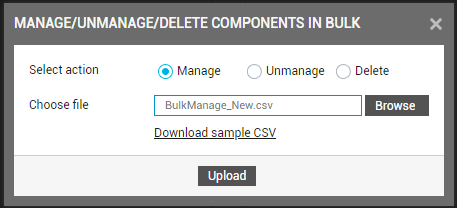
Figure 10 : Uploading the CSV file containing the details of components to be managed in bulk
- Once the CSV file is successfully uploaded to the eG manager, the manager will use the eG CLI to execute commands for managing all the components configured in the CSV file.
-
If the bulk management succeeds/fails, a message to the corresponding effect will appear. To troubleshoot failures, use the egCLI.log file in the <EG_MANAGER_INSTALL_DIR>\manager\logs directory (in Windows; in Unix, this will be /opt/egurkha/manager/logs directory).
For unmanaging components in bulk, do the following:
- Login to the eG admin interface.
- Follow the Infrastructure -> Components -> Manage/Unmanage/Delete menu sequence.
-
In Figure 7 that then appears, click the Bulk Manage/Unmanage/Delete button.
-
Figure 11 will then appear. To unmanage components in bulk, select the Unmanage option from Figure 11.
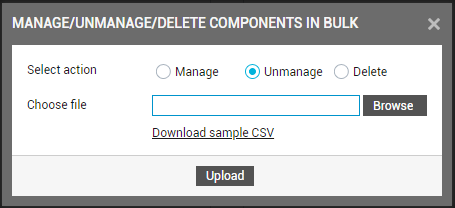
-
Typically, you need to enter the details of all the components you want to unmanage in a CSV file. This file should then be uploaded to the eG manager, so that all the components configured in the CSV file are unmanaged at one shot. To help you build this CSV file quickly, eG Enterprise provides you with a ready-to-use template. Click on the Download sample csv link in Figure 11 to download this CSV sample/template to the local host.
-
Next, proceed to edit the downloaded CSV sample/template. The template is pre-configured with columns to capture information pertaining to components. These columns are, namely - component type, component name, component IP address/host name, port number, and SID (which is applicable only to Oracle database servers). When editing the template, make sure you fill each column with the information related to the component you want to manage. Columns not applicable to the component being managed can be left empty - for example, if you unmanaging a Windows server, you need not provide a port number and an SID. A single row in the CSV file will contain all the details required for unmanaging a single component. For unmanaging multiple components therefore, multiple rows of data will have to be provided, as depicted by Figure 9.

Figure 12 : Editing the CSV sample/template to include the details of all components to be unmanaged in bulk
Note:
You can add rows of component information to the CSV file, but you should not add new columns to it. Nor can you change the labels of the existing columns.
-
Once the CSV file is filled in and is ready to be uploaded, save the file. When saving, you can change the name and/or location of the file, if you so want.
Note:
Make sure that you do not change the file type (.csv) when saving the file.
-
Then, using the Browse button in Figure 11, browse for the location of the CSV file. Once the location is specified (see Figure 10), click the Upload button to upload the file to the eG manager.
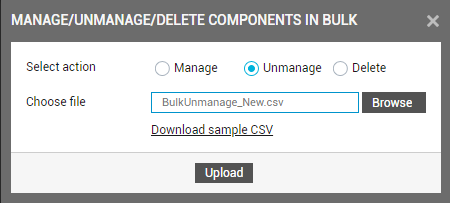
Figure 13 : Uploading the CSV file containing the details of components to be unmanaged in bulk
- Once the CSV file is successfully uploaded to the eG manager, the manager will use the eG CLI to execute commands for unmanaging all the components configured in the CSV file.
-
If the bulk unmanagement succeeds/fails, a message to the corresponding effect will appear. To troubleshoot failures, use the egCLI.log file in the <EG_MANAGER_INSTALL_DIR>\manager\logs directory (in Windows; in Unix, this will be /opt/egurkha/manager/logs directory).
For deleting components in bulk, do the following:
- Login to the eG admin interface.
- Follow the Infrastructure -> Components -> Manage/Unmanage/Delete menu sequence.
-
In Figure 7 that then appears, click the Bulk Manage/Unmanage/Delete button.
-
Figure 11 will then appear. To delete components in bulk, select the Delete option from Figure 11.
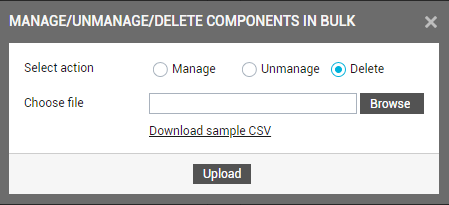
-
Typically, you need to enter the details of all the components you want to delete in a CSV file. This file should then be uploaded to the eG manager, so that all the components configured in the CSV file are deleted at one shot. To help you build this CSV file quickly, eG Enterprise provides you with a ready-to-use template. Click on the Download sample csv link in Figure 11 to download this CSV sample/template to the local host.
-
Next, proceed to edit the downloaded CSV sample/template. The template is pre-configured with columns to capture information pertaining to components. These columns are, namely - component type, component name, component IP address/host name, port number, and SID (which is applicable only to Oracle database servers). When editing the template, make sure you fill each column with the information related to the component you want to delete. Columns not applicable to the component to be deleted can be left empty - for example, if you are deleting a Windows server, you need not provide a port number and an SID. A single row in the CSV file will contain all the details required for deleting a single component. For deleting multiple components therefore, multiple rows of data will have to be provided, as depicted by Figure 9.

Figure 15 : Editing the CSV sample/template to include the details of all components to be deleted in bulk
Note:
You can add rows of component information to the CSV file, but you should not add new columns to it. Nor can you change the labels of the existing columns.
-
Once the CSV file is filled in and is ready to be uploaded, save the file. When saving, you can change the name and/or location of the file, if you so want.
Note:
Make sure that you do not change the file type (.csv) when saving the file.
-
Then, using the Browse button in Figure 11, browse for the location of the CSV file. Once the location is specified (see Figure 10), click the Upload button to upload the file to the eG manager.
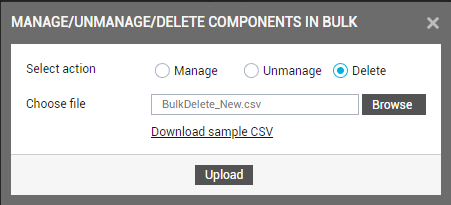
Figure 16 : Uploading the CSV file containing the details of components to be deleted in bulk
- Once the CSV file is successfully uploaded to the eG manager, the manager will use the eG CLI to execute commands for deleting all the components configured in the CSV file.
-
If the bulk deletion succeeds/fails, a message to the corresponding effect will appear. To troubleshoot failures, use the egCLI.log file in the <EG_MANAGER_INSTALL_DIR>\manager\logs directory (in Windows; in Unix, this will be /opt/egurkha/manager/logs directory).
